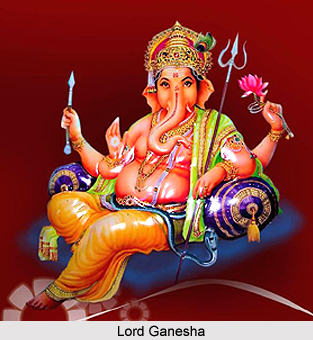 The Sankatahara Ganapati Vrata is perhaps the most effective among all types of vratas of Lord Ganesha. It is generally commenced on the Shravana Bahula Chaturthi day that falls on the fourth day of the dark fortnight in the month of Shravana. The ritual is continued for a full year. Therefore, the rituals are performed on every Bahula Chaturthi during the night. It is believed by the devotees of Lord Ganesha that the Sankatahara Ganapati Vrata relieves a person from all obstacles and hindrances.
The Sankatahara Ganapati Vrata is perhaps the most effective among all types of vratas of Lord Ganesha. It is generally commenced on the Shravana Bahula Chaturthi day that falls on the fourth day of the dark fortnight in the month of Shravana. The ritual is continued for a full year. Therefore, the rituals are performed on every Bahula Chaturthi during the night. It is believed by the devotees of Lord Ganesha that the Sankatahara Ganapati Vrata relieves a person from all obstacles and hindrances.
The particular day for the performance of this ritual occurs only once in seven years. It occurs on the simultaneous occurrence of Magha month, Krishna Paksha, which is the fortnight before the new moon, Chaturthi tithi, Tuesday and the time of the rise of moon.
The performer of the vrata is required to wake up before sunrise and worship the Supreme Lord after having a bath. He will then adore Lord Ganesha and do a Sankalpa. The person is also required to have sacred thoughts and fast for the entire day. Later in the evening he is needed to bathe with powder from white sesame seeds and Tilamalaka churna (gooseberry seeds). He will also form an idol of the elephant-headed deity with turmeric powder or mud. The devotee will then perform an Avahanam and pray to Ganesha to reside in that statue.
The performer of the Sankatahara Ganapati Vrata will also worship the Lord with incense sticks, flowers and prayer candles (Deepa). It is mandatory that the devotee worships Ganesha with Durva grass or Bermuda grass. The grass may consist of three leaves, five leaves or seven leaves. The person can adore the idol with twenty one or more twigs of Durva grass. He is also required to recite any of mantras of Lord Ganesha for at least forty eight minutes. Then he will offer Harathi and Nivedya to Ganesha and finish the puja by moon-rise. He will then view the moon and pray to Lord Chandra (moon) and Chaturthi tithi and offer Arghya to both. Then after praying to Lord Ganesha, the performer is required to offer Prasada to Brahmanas (Brahmins) and other devotees. He should also be awake at night and recite Ganesha mantras and worship the deity.
The devotee will then perform Udyapanam and pray to the Lord to return back from the figure of Ganesha. Finally the image of Lord Ganesha is to be immersed in the flowing waters of river.
The importance and benefits of Sankatahara Ganapati Vrata is described in Ganesha Purana. When a devotee performs the vrata, he gets rid of handicap, gets rid of the sin of Brahmahatya, gets rid of Kuja Dosha (Manglik Dosha), blessed with children, blessed to become a king etc. It is also conducted to control anger, cure leprosy, escape from unexpected death, cure Tuberculosis, free from slavery, acquiring lost objects, blessed with divine knowledge, vitality, blessings of Guru, victory in war and others. Apart from these, the devotees of Lord Ganesha also performs the Sankatahara Ganapati Vrata to get rid of obstructions for marriages, to be relieved of all bad effects in their horoscope, to meet lost relatives and to be blessed with children.
If a person performs the Sankatahara Ganapati Vrata for one day, he will be blessed with success and happiness and will attain a place in Ganesha Loka.









